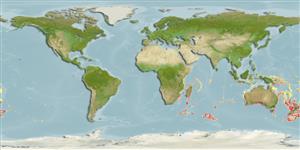>
Notacanthiformes (Halosaurs and deep-sea spiny eels) >
Halosauridae (Halosaurs)
Etymology: Halosaurus: Greek, als, alis = salt + Greek, sauros = lizard (Ref. 45335).
Environment: milieu / climate zone / depth range / distribution range
Ecología
marino batidemersal; rango de profundidad 600 - 1270 m (Ref. 44037). Deep-water
Southwest Pacific.
Tamaño / Peso / Age
Maturity: Lm ? range ? - ? cm
Max length : 68.0 cm TL macho / no sexado; (Ref. 9563)
Short description
Claves de identificación | Morfología | Morfometría
Radios blandos dorsales (total) : 10 - 13. Body white pinkish or pink, head lighter colored.
A temperate species (Ref. 7300) occurring on the continental slope (Ref. 9563, 75154).
Life cycle and mating behavior
Maturities | Reproducción | Spawnings | Egg(s) | Fecundities | Larva
May, J.L. and J.G.H. Maxwell, 1986. Trawl fish from temperate waters of Australia. CSIRO Division of Fisheries Research, Tasmania. 492 p. (Ref. 9563)
IUCN Red List Status (Ref. 130435)
Threat to humans
Harmless
Human uses
Herramientas
Special reports
Download XML
Fuentes de Internet
Estimates based on models
Preferred temperature (Ref.
123201): 2.5 - 8, mean 6 °C (based on 277 cells).
Phylogenetic diversity index (Ref.
82804): PD
50 = 0.5020 [Uniqueness, from 0.5 = low to 2.0 = high].
Bayesian length-weight: a=0.00087 (0.00033 - 0.00229), b=3.07 (2.84 - 3.30), in cm total length, based on LWR estimates for this (Sub)family-body shape (Ref.
93245).
Nivel trófico (Ref.
69278): 3.4 ±0.4 se; based on size and trophs of closest relatives
Resiliencia (Ref.
120179): Medio, población duplicada en un tiempo mínimo de 1.4-4.4 años (Preliminary K or Fecundity.).
Fishing Vulnerability (Ref.
59153): Moderate to high vulnerability (47 of 100).
